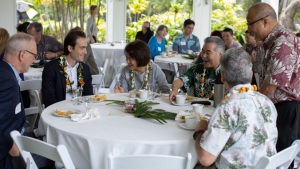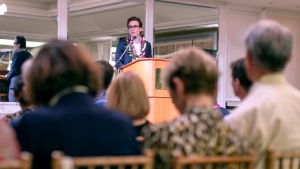What will climate change really feel or look like? For many, images of destructive sea-level rise and an upswing in extreme weather immediately flood the mind. But some scientists say that just scratches the surface.
The University of Hawaiʻi has long been at the forefront of research into the impacts climate change will bring to the state. Now UH is helping to attract more awareness to what has been dubbed, “climate chaos.”


The UH Mānoa Better Tomorrow Speaker Series invited David Wallace-Wells, best-selling author of The Uninhabitable Earth: Life After Warming to meet with state and environmental leaders. He also gave the keynote speech at the 2020 Hawaiʻi Climate Conference, Hā O Ke Kai at East-West Center and a UH sponsored public lecture at The Kahala Hotel & Resort.
Wallace-Wells revealed alarming research on how climate change will drastically transform human life. Some projections highlight the relationship between rising temperatures and violence and show it could lead to more wars, murders and domestic assaults.
“I often see people, their faces go ashen, their eyes grow wide, and I can tell that they’re thinking that’s an unconscionable level of suffering and dying and they’re right about that,” Wallace-Wells said.
Critics refer to the 37-year-old’s book as both compelling and apocalyptic. Wallace-Wells doesn’t consider himself a traditional environmentalist. The New York native has never hiked, camped or even owned pets. But said his interest in publishing work based on climate change ignited after learning about unprecedented impacts global warming could have on civilization. Some findings show air pollution will kill 150 million people by 2050.
I often see people, their faces go ashen, their eyes grow wide, and I can tell that they’re thinking that’s an unconscionable level of suffering and dying and they’re right about that.
—Wallace-Wells
“If you feel yourself concerned about climate change or consumed with climate anxiety, even talking about it with those around you is a political action and can start to move conversations in public engagement,” he explained.
Wallace-Wells said the key to tackling gripping projections about the planet’s future is drumming up public concern and advocating for policy change. His keynote address sparked eye-opening conversation among crowds at Hā O Ke Kai, which included a number of state leaders, including Gov. David Ige.
”Climate change is already impacting our island state. Coral bleaching is killing off our precious reefs. And sea level rise is chomping up a chunk of our coastlines. We’re committed to combating global warming by working toward becoming carbon neutral. It’s an aggressive but vital pledge to protecting our planet,” Gov. Ige said.
Hawaiʻi leaders have begun preparing for the effects of climate change. UH experts are among those who sit on commissions and teams looking at ways to prepare the islands.
Some steps that have been initiated include a goal to generate 100 percent clean energy by 2045. It was the first state in the nation to sign that commitment into law.
Learn more about UH’s research on climate change.
—By Moanikeʻala Nabarro

